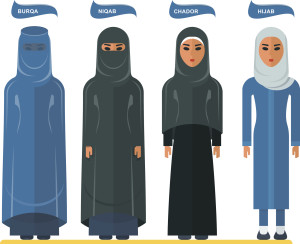
Over the summer, many cities in France attempted to ban the burkini on the beaches. Interestingly, here in the United States, girls in schools face a similar but different problem. While the French want to see more skin on the beach, schools want girls to cover up so that they don’t distract the boys. Let’s save the school debate for another day and discuss the burkini, the burqa ban and women’s rights when it comes to dress.
First, you should know the difference between the different styles of Muslim dress. What’s the difference between a burqa, hijab and niqab? The hijab is used to describe the headscarf worn by Muslim women. Typically, it leaves the face clear but covers the hair and neck. The niqab is the veil that covers the face but leaves the eyes clear. The burqa is the most concealing. Typically, it is a one-piece headscarf and veil that only has a mesh screen for the person to see through. For the record, the burkini is a piece of modest swimwear designed for Muslim women (and others) to wear on the beach.
Although Muslim women are not the only people to wear head coverings, the burqa, hijab and niqab are more controversial. In some Middle Eastern countries, the hijab is compulsory. In Western communities, such as Europe, the United States and Canada, many believe that wearing the burqa is a sign of submission or oppression. France, Belgium and the Netherlands all have specific bans against the niqab or burqa. Certain cities in Switzerland, Italy and Spain have also banned the burqa and niqab. Just recently, Bulgaria joined the ranks of these countries by banning burqas in public.
Burqa Bans in the Muslim World
Islam is the predominant religion in the Middle East and many countries in Africa. The burqa, hijab and niqab are still debated in many of these countries. Here are some of the rules concerning head coverings for women:
- Afghanistan – Although the burqa is not mandatory, there is still social pressure to wear the burqa in public.
- Chad – The burqa has been banned for security purposes since June 2015.
- Gambia – Because the country is a secular nation, it does not enforce the hijab. However, a small minority of women do wear it.
- Indonesia – The hijab is referred to as “jilbab” in Indonesia and is not mandatory in this country. However, many women are choosing to wear it, especially for religious services.
- Jordan – This country does not ban or require headscarves, and the hijab is more of a fashion statement than a religious one.
- Kosovo – Kosovo has banned the hijab in universities, government buildings and public schools since 2009.
- Morocco – The headscarf is frowned upon but not forbidden. It might be considered a political statement to wear a hijab or burqa in this country.
- Saudi Arabia – Women who live in Saudi Arabia are expected to cover themselves. Although the niqab is preferred, many are beginning to wear only the headscarf.
- Sudan- It’s in the nation’s Constitution that Sudanese women are required to wear the hijab when in public.
Do Women Have Rights?
As you can see, even in Muslim countries, there is much controversy over the wearing of the hijab and burqa. If we believe that all women have the right to dress as they want, it would be inappropriate to ban them from wearing headscarves and covering their face except in certain situations when they do need to be identified. The debate about the burqa, burkini and hijab is not over, but we can better understand the importance of this dress by understanding the heritage. Although there are men and women who might take advantage of the dress to make a political statement, it’s not right to limit the rights of all women by banning the burqa.

